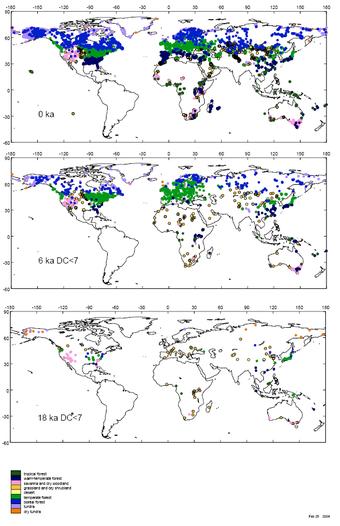
(Click on the figure to get a bigger version)
Most dynamic vegetation models (DGVMs) simulate far fewer PFTs, and hence discriminate far fewer biomes, than the palaeodata allow. In order to facilitate direct comparison with model output, we have grouped the observed biomes into broader units (mega-biomes) on the basis of their structure and functioning. The table below shows how the observed biomes recognised in Version 4.1 of the BIOME 6000 data set are grouped into mega-biomes. If you wish to use this version of the data set, please cite Harrison and Prentice (2003) as the source of the mega-biome classification.
| Original biome classification | Mega-biome classification |
|---|---|
| Tropical evergreen broadleaf forest | Tropical forest |
| Tropical semi-evergreen broadleaf forest | |
| Tropical deciduous broadleaf forest and woodland | |
| Warm-temperate evergreen broadleaf and mixed forest | Warm-temperate forest |
| Warm-temperate evergreen broadleaf forest | |
| Warm-temperate rainforest | |
| Wet sclerophyll forest | |
| Cool evergreen needleleaf forest | Temperate forest |
| Cool mixed forest | |
| Cool-temperate rainforest | |
| Cool-temperate evergreen needleleaf and mixed forest | |
| Temperate evergreen needleleaf forest | |
| Temperate deciduous broadleaf forest | |
| Cold deciduous forest | Boreal forest |
| Cold evergreen needleleaf forest | |
| Temperate sclerophyll woodland and shrubland | Savanna and dry woodland |
| Temperate evergreen needleleaf open woodland | |
| Tropical savanna | |
| Temperate deciduous broadleaf savanna | |
| Tropical xerophytic shrubland | Grassland and dry shrubland |
| Temperate xerophytic shrubland | |
| Tropical grassland | |
| Temperate grassland | |
| Steppe | |
| Xerophytic woods/scrub | |
| Temperate grassland and xerophytic shrubland | |
| Desert | Desert |
| Graminoid and forb tundra | Dry tundra |
| Cushion-forb tundra (cushion forb, lichen and moss tundra) | Tundra |
| Erect dwarf-shrub tundra | |
| Low and high shrub tundra | |
| Prostrate dwarf-shrub tundra | |
| Tundra | |
| Alpine grassland |

(Click on the figure to get a bigger version)
If you wish to use this global data set, you should cite Prentice et al. (2000), Harrison et al. (2001), Bigelow et al. (2003) and Pickett et al. (2004) as the sources of the original data, and the following website (http://www.bridge.bris.ac.uk/resources/BIOMES_data/BIOME_v4.2.htm) as the source for the homogenised nomenclature. If you wish to use only regional subsets of the data, you should cite the appropriate regional reference (as given in the table below), and the above website as the source for the homogenised nomenclature.
New data syntheses are currently being produced for three regions:
As soon as these papers are accepted for publication, we will produce a new version of the BIOME 6000 data set (Version 5) and update this website.
Technical queries about the data sets should be addressed to Sandy Harrison or Mark Creighton.
We would like to take this opportunity of thanking the hundreds of palynologists who contributed to the BIOME 6000 compilation directly, or indirectly by providing their data to public-access pollen databases, and to thank IGBP-GAIM for their sponsorship of the project. BIOME 6000 (and its daughter projects) has received funding support from IGBP-GAIM, IGBP-PAGES, IGBP-DIS, The Royal Swedish Academy of Sciences, the Swedish Natural Science Research Council (NFR), the Swedish Institute, and the Max-Planck Institute for Biogeochemistry.